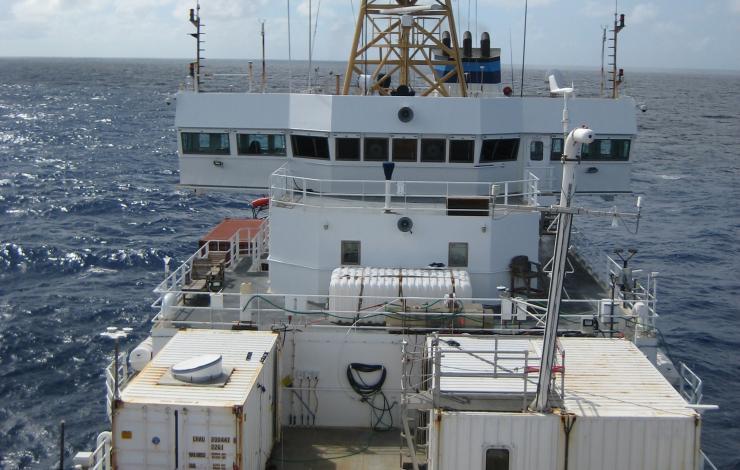
A view of the ship from the top of the forward mast. From left to right on the lower deck is the NOAA ESRL radar container with upward-pointing W-band radar measuring clouds and rain, the NOAA ESRL CSD lidar measuring wind, aerosol and clouds, and the NOAA PMEL air quality sampling van with aerosol inlet. (Photo: Sergio Pezoa)
PMEL's Atmospheric Chemistry Group has been participating in the Atlantic Tradewind Ocean-Atmosphere Mesoscale Interaction Campaign (ATOMIC) onboard the RV Ronald H. Brown in the tropical North Atlantic east of Barbados.
The six-week scientific campaign involves a unique combination of manned and unmanned aircraft and ships including newly developed capabilities using UAVs, saildrones, and underwater gliders to investigate how the ocean, atmosphere, and shallow clouds work together to create the weather and climate we live in. Scientists are gathering information on shallow convection clouds, the effects of aerosols and clouds on the ocean surface energy budget, and mesoscale oceanic processes – all of which are relevant to the propagation of Madden-Julian Oscillations (MJOs), hurricane track and intensity, annual movement of the Intertropical Convergence Zone (ITCZ), midlatitude storm tracks, and marine stratocumulus cloud regions.
PMEL is measuring aerosol properties including number concentration as a function of particle size, chemical composition, scattering and absorption of solar radiation, and cloud drop nucleating ability. These data will be used to investigate the impacts of aerosol particles on the region’s radiation budget and, in turn, the impact of atmospheric dynamics on aerosol properties.
ATOMIC is the U.S. component of a collaborative effort that includes Germany, France, United Kingdom, United States, and Barbados called EUREC⁴A (Elucidating the Role of Clouds-Circulation Coupling in Climate). Together, ATOMIC and EUREC4A will involve 4 research vessels, 4 research aircraft (including the NOAA P3), land-based observations from Barbados, and unmanned sea-going vehicles. ATOMIC involves experts from NOAA (PMEL and ESRL), NOAA pilots and crew, the Caribbean Institute for Meteorology and Hydrology, several universities, and other partners.
Dr. Patricia Quinn has been serving as Chief Scientist for Leg 1. Read more on NOAA research: https://research.


